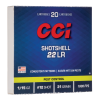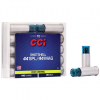
Some new shot cartridges caught this correspondent’s eye at the CCI part of the Vista Outdoors exhibit at the SHOT Show. There were three displayed: a 10mm offering using 109 grains of #9 lead shot, a 9mm using 43 grains of Hevi Bismuth, non-lead shot, and a .38 Special using 80 grains of Hevi Bismuth, non-lead shot.
The 10mm is to satisfy those with 10mm handguns who find a shot cartridge useful for their needs. The Hevi Bismuth loads are to satisfy customers who want to be certain about their status on the law, where lead shot is prohibited. A CCI representative said most of the demand for the Hevi Bismuth loads comes from the western United States. Testing of the Hevi Bismuth loads shows comparable results to current lead loads.
Live Inventory Price Checker

|
CCI/Speer CCI Shotshell 22WMR 52 Grain Shotshell #12 20/BX 2000/CS | GrabAGun | $ 12.99 |
|

|
CCI Shotshell 38 Special 100gr No. 9 Shot Handgun Ammo - 10 Rounds | Sportsman's Warehouse | $ 18.99 |
|

|
CCI Shotshell .22LR Ammo 31gr #12 20 Rounds | GunMag Warehouse | $ 10.99 $ 9.99 |
|

|
CCI Shotshell Pest Control 44 | Midsouth Shooters Supply | $ 20.99 |
|
This correspondent has sources who have experimented with the Tungsten Super Shot (TSS). The performance of TSS is far, far beyond lead shot. TSS is extremely dense, 18.3 grams per cubic centimeter, compared to about 11.3 grams per cubic centimeter for lead shot. TSS is about 60% more dense than lead, which gives it a tremendous ballistic advantage. TSS appears to be a natural for pistol shot cartridges, which are primarily limited by the small volumes of shot available. Because of the difference in density, a similar shot cartridge could fit in 60% more shot. Because of the combination of hardness and density, shot sizes can be dropped by at least two levels for similar terminal effects.
This correspondent asked: Why not switch to TSS? Pistol shot shells are already relatively expensive because they are produced in such small numbers. The increased cost of using TSS shot would primarily be in the cost of the shot. Lead costs about $2 per pound, TSS about $42 per lb. The amount of shot in a pistol shotshell is small, about 1/4 ounce for the larger calibers. With TSS, it could be increased by 60% to .4 ounces. 16×2.5 is 40 shots per pound, or about $1 more per shot. With small, hard shot, serious patterns at further ranges become likely. Dropping two shot sizes roughly doubles the pellet count. Adding 60% more throw weight means about twice as many smaller but effective pellets.
The people at CCI can read the research and do the math better than this correspondent. They have tested TSS in pistol caliber shotshells. My source told me the results are much superior to lead shot. The problem is not a technical problem. TSS and pistol shotshells are a beautiful match. The problem is not an economic one. Pistol shotshells are used in small enough quantities that most people can afford another dollar a cartridge. The problem is legal. Tungsten Super Shot has been ruled by the ATF to be an armor-piercing material. It is banned for use in pistols because of the old “cop killer” legislation passed when Joe Biden was a senator. Anyone who produces a shotshell for pistols using TSS is likely to be shut down by the ATF.
It is possible an exemption, as it is especially useful for sporting purposes, could be granted. It is highly unlikely under the Biden administration.
This is technological progress stopped by bureaucratic political games. Such is the problem with passing legislation based on emotion and technological ignorance. Emotion and ignorance were the combination used by President Biden when he helped pass the “cop killer” armor-piercing bullet ban as a senator.
About Dean Weingarten:
Dean Weingarten has been a peace officer, a military officer, was on the University of Wisconsin Pistol Team for four years, and was first certified to teach firearms safety in 1973. He taught the Arizona concealed carry course for fifteen years until the goal of Constitutional Carry was attained. He has degrees in meteorology and mining engineering, and retired from the Department of Defense after a 30 year career in Army Research, Development, Testing, and Evaluation.








I use the .22 for field rats and small poisonous critters, the .40 and .45 ACP for rattlers when out on the Texas border. Much better than trying to play John Wayne with a .40 against a snake.
This is a very timely article for me. I have shot shells for my 44Mag and 45ACP. It was on my mind to check if there was any such critters for the 9mm that I carry most often. I have a couple of large dogs that are hankering to be shot one of these days on my morning hike on my country road. I’d like the first shot to be a shot shell in hopes that the next rounds wouldn’t be necessary.
Maybe I finally found a use for that old, worn-out 1911 barrel.
Wouldn’t tungsten be hard on a barrel?
I’ve carried snake shot in a 45acp and other than firing a few rounds for volume, recoil, and pattern testing, it’s not something would shoot regularly.
Im just guessing that the durometer of tungsten must be a bit higher than lead.